Unveiling the Stealthy Assassins
“Silent killer diseases” are conditions that progress silently and often go unnoticed until they cause significant or severe health issues. These diseases can be particularly dangerous because the individuals may not be aware they have a condition until it’s advanced. Here are 10 most common diseases often referred to as “silent killers.

A Roll Call of Known Delinquents (KDs) Lurking Unseen
- Hypertension (High Blood Pressure)
- Type 2 Diabetes Mellitus
- Chronic Kidney Disease(CKD)
- Glaucoma
- Osteoporosis
- Carbon Monoxide Poisoning
- Hepatitis B and C
- Human Immunodeficiency Virus(HIV)
- Sleep Apnea
- Chlamydia and Gonorrhoea
Unmasking the Ninjas: One Stealthy Step at a Time
Diving into the shadowy world of silent but deadly foes is like peeling back the layers of an onion, only instead of tears, you’re greeted with a mix of awe and a dash of fear. We’re not talking about your garden-variety assassins or cloak-and-dagger types. Nope, we’re unmasking those everyday ninjas that creep up on you without a sound mind.

From the silent but deadly heart disease that sneaks up like a cat burglar, to diabetes, the sugar-coated saboteur, and let’s not forget hypertension, the silent screamer that’s all pressure, no pain. These stealthy villains, including cancer, stroke, and a few more, make up the most wanted list of health’s most elusive adversaries. So, lace up your detective boots, because spotting these sneaks requires a keen eye and a healthy dose of vigilance.
1. Hypertension: The Stealthy Pressure Cooker Whistling Under Your Radar”
The undercover agent
Alright, picture this: Hypertension, the ultimate undercover agent, has been secretly plotting against your peace and quiet, setting up camp in the bustling metropolis of your bloodstream without even a hint of its presence. It’s like that unwanted guest at your party who somehow manages to blend into the crowd, sipping on your expensive wine and nodding along to the music, all while plotting to crash your system’s mainframe.
Storm in tea cup
Now, imagine your body’s organs throwing their own little soirees, blissfully unaware of the chaos brewing. Your heart’s pumping beats like a DJ at a rave, your arteries are the dance floor – flexible, pulsing with life. But then, hypertension decides to turn up the volume. The pressure’s on, quite literally, and suddenly, your smooth-flowing soiree is on the verge of turning into an out-of-control block party with the potential for disastrous after-effects: heart attacks with the impact of a bass drop, strokes that remix your reality, and kidney failure that ends the party way too soon.

Turn the tables
The twist? You’re the master of ceremonies. You can flip the script on this silent gatecrasher with some lifestyle grooves – cutting back on the salt shaker’s solo, moving and shaking to the rhythm of regular exercise, and keeping the stress levels on mute. It’s about tuning into your body’s signals, even when they’re whispering.
So, let’s not let hypertension DJ our life’s playlist. By turning the tables on this silent intruder, we can keep our internal rave going strong – heart happy, blood flowing smoothly, and every organ in the crowd living it up, oblivious to the fact that they were ever at risk of a party foul. Here’s to living loud, healthy, and hypertension-free. Let the good times roll, without the uninvited guest!
2. Diabetes: That Sugar-Coated Ninja Quietly Turning Desserts into Dangers
The secret of the sugar parties
Alright, let’s talk about that sneaky character lurking in the shadows of your metabolism, Type 2 Diabetes Mellitus, or as I like to call it, “The Sweet Betrayer.” Picture this: it’s like having a roommate who seems cool at first, paying rent on time (your body managing sugar levels like a champ), but then starts throwing secret sugar parties in your living room (bloodstream) while you’re sleeping. And the kicker? They don’t even invite you!

Back stage stabber
Now, in the early stages, this roommate is super stealthy. You won’t hear a peep. You’re living your life, enjoying your cupcakes and soda, while Type 2 Diabetes is quietly moving in more of its stuff, turning your body’s sugar management system into a hoarder’s paradise. It’s like one day, you realize your cozy home (body) is now a storage unit for excess sugar, and you didn’t even see the lease agreement.
The long-term lease on this situation? Not great. The sugar overload starts messing with the heart, turning those sweet beats into troubled rhythms. It whispers sweet nothings to your blood vessels, leading to a not-so-sweet buildup of problems. Your eyes, once sharp as an eagle’s, might start seeing the world through a frosted lens. Kidneys, the body’s filtration system, get overwhelmed, and nerves? They start sending mixed signals or sometimes, ghosting you completely.
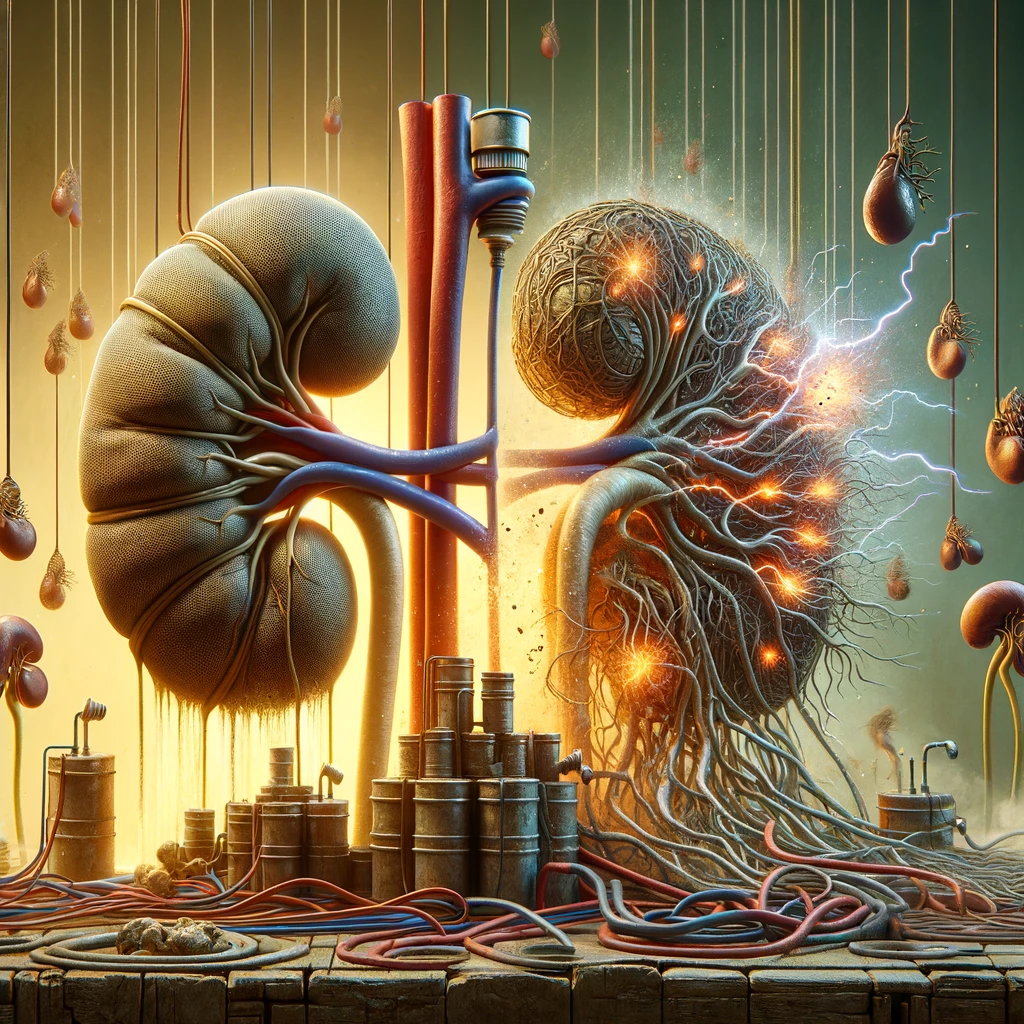
Who’s calling the shots
But here’s the plot twist: you have the power to evict this sneaky roommate. A little shake-up in your lifestyle—think of it as choosing water over soda, a salad over fries, and taking the stairs over the elevator—can start the process. It’s about turning the tables, or in this case, the pantry, and showing Type 2 Diabetes that when it comes to your body’s health, you’re the one calling the shots.
So, let’s not let “The Sweet Betrayer” turn our bodies into its permanent crash pad. By keeping an eye on the sneaky signs and making some plot adjustments, we can write a healthier storyline for ourselves. After all, who needs a sugar-coated life when you can enjoy the real sweetness of good health?
3. CKD: The Undercover Saboteur in the Plumbing of Your Body—Time to Flush It Out Before the Pipes Burst!
The ninja in the night
Meet Chronic Kidney Disease (CKD), the ultimate silent lurker in the world of health, sneakily sliding through your system like a ninja in the night. Think of CKD as that quiet roommate who never makes a peep, cleans up silently, and seems practically invisible—until one day, boom, you find out they’ve been slowly turning the living room (your body) into a wasteland, and now you’re on the hook for a massive cleanup operation (hello, dialysis or kidney transplant).
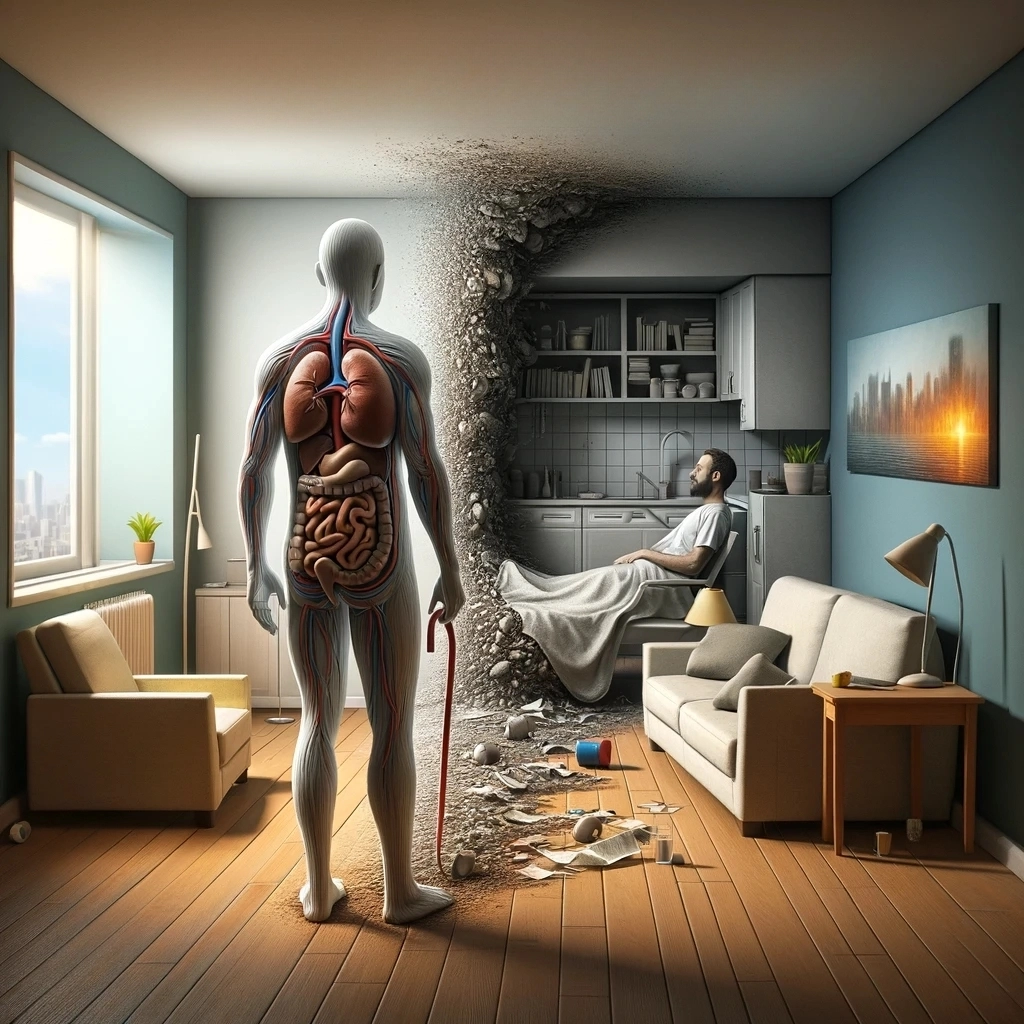
CKD is like the stealthy app running in the background of your smartphone, slowly but surely draining the battery (your health) and you’re none the wiser until your phone (body) suddenly shuts down in the middle of an important call (life). It’s there, quietly biding its time, making small, almost imperceptible changes to your kidneys’ filtering abilities, until one day, your kidneys decide to go on strike, demanding better working conditions or an outright replacement.
Master of disguise
The tricky bit about CKD is that it’s a master of disguise. It doesn’t send out flashy warning signals or dramatic SOS flares. No, it prefers to keep its destructive work hush-hush, letting you believe everything is business as usual, while it’s actually throwing a wrench into your body’s waste disposal system, leading to a toxic buildup that could put a landfill to shame.

But fear not! The tale of CKD doesn’t have to end in tragedy. By playing detective with regular check-ups and keeping tabs on your health stats, you can catch this sneaky intruder red-handed before it calls for backup. Lifestyle tweaks—like eating a kidney-friendly diet, keeping your blood pressure in check, and staying hydrated—are your gadgets in this espionage game against CKD.
4. Glaucoma: The Silent Thief of Sight, Waiting in the Shadows to Rob You of Your Vision’s Treasure.
Oh, glaucoma! That sneaky, silent burglar of sight, lurking in the shadows like a comic book villain plotting to steal the precious treasure of vision. Picture this: inside your eye, there’s a constant flow of fluid, right? It’s like a tiny river keeping everything moist and nourished. But in the world of glaucoma, things get a bit… clogged. Imagine your eye’s drainage system throwing a tantrum, refusing to work properly, causing a traffic jam of fluid that pushes up the pressure inside your eye. And who’s the victim? The optic nerve, that crucial cable connecting your eye to your brain, carrying all those beautiful images you see every day.
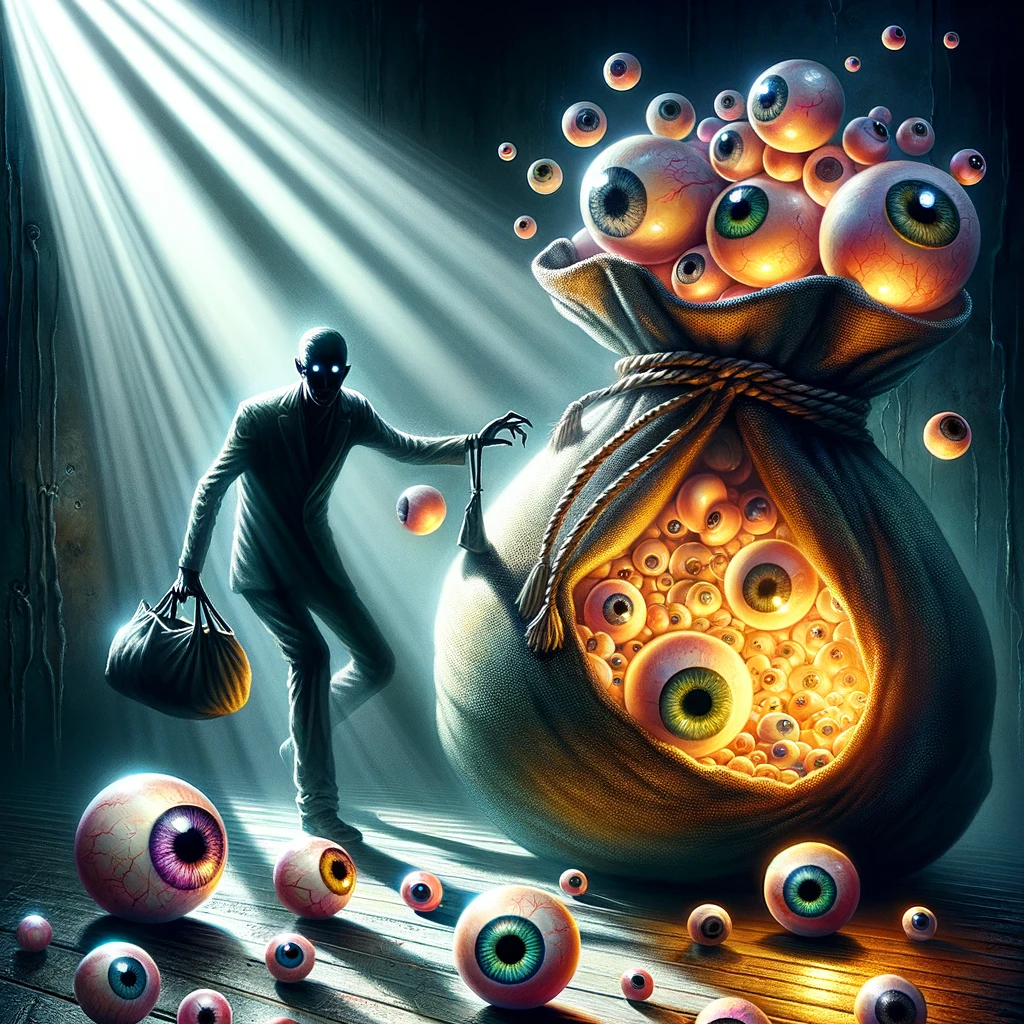
Now, glaucoma isn’t just one big baddie; it’s more like a band of villains, each with its own dastardly plan to sabotage your sight. Some sneak up on you slowly, giving you no warning signs until they’ve already done some damage. Others storm in like a tempest, causing pain and blurred vision, demanding immediate attention.
The real kicker? The damage glaucoma does is as stealthy as it is serious. It’s like it tiptoes around, leaving no footprints, taking bits of your vision from the edges inward. You might not even notice anything’s amiss until you’re squinting at the world through a tunnel.
But fear not! While glaucoma might sound like it’s got all the power, we’ve got some tricks up our sleeves. Early detection is our superhero ally. Regular eye exams are the secret weapon, unveiling glaucoma’s presence before it can unleash its full fury. And if it dares show its face? Treatments like eye drops, laser therapy, or surgery can kick it to the curb, protecting your optic nerve and preserving your precious sight.
So, let’s not give glaucoma the satisfaction of victory. Keep those peepers checked, and stay one step ahead of the game. Because in the epic saga of you versus glaucoma, we’re all rooting for you to win!
5. Osteoporosis: The only time you can break a leg just by taking a bow.”
Osteoporosis is a medical condition characterized by decreased bone density and quality, resulting in bones that are fragile and more prone to fractures. This condition is often referred to as a “silent disease” because it can progress without any symptoms until a bone breaks. The most common fractures associated with osteoporosis occur in the hip, spine, and wrist.
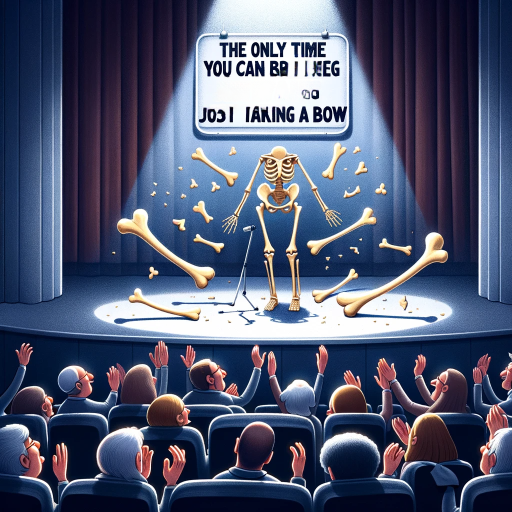
Bone is a living tissue that is constantly being broken down and replaced. Osteoporosis occurs when the creation of new bone doesn’t keep up with the loss of old bone. Risk factors for developing osteoporosis include aging, hormonal changes (particularly in postmenopausal women), family history, low body weight, and certain medications, among others.
Prevention and treatment strategies for osteoporosis aim to strengthen bone health and include calcium and vitamin-D supplementation, regular physical exercise (especially weight-bearing and muscle-strengthening exercises), and medications that can help prevent bone loss and rebuild bone.
Early detection is crucial for managing osteoporosis effectively. Bone density tests can help diagnose the condition early, allowing for interventions that can decrease the risk of fractures and their associated complications.
6. When carbon monoxide tries to sneak into your house like a silent but deadly fart, but your CO detector is like, ‘Not today, sneaky gas!
Oh, carbon monoxide (CO), that sneaky little devil! It’s like the ultimate ninja of the gas world, slipping into your space undetected because it’s got no color, no smell, and absolutely no taste. You won’t even know it’s there, chilling with you, until it’s possibly too late. Imagine inviting a ghost into your house that you can’t see, smell, or hear, but it’s slowly making you sick. That’s CO for you!

This silent but deadly gas is a real trickster. It’s like it plays hide and seek, except it’s really good at hiding and terrible for your health when it finds you. The scary part? It can lead to some serious health issues or, in the worst-case scenario, it can be a silent ticket out of this world, and you wouldn’t even have a warning. Like, one moment you’re chilling, thinking everything’s fine, and the next, you’re feeling all sorts of off because this uninvited guest is hogging the oxygen your body needs.
The irony? It comes from stuff we use all the time, like cars, stoves, or that old heater you swear by during the winters. They’re all potential CO VIP party hosts. So, what do we do? Well, it’s all about keeping an eye on those silent assassins, making sure they’re behaving, and installing a carbon monoxide detector to crash their party before it even starts. Think of it as your personal CO bouncer, keeping the bad vibes out.

In the end, staying safe from CO is all about knowing the game it plays. Keep it out, check your appliances, and maybe keep a CO detector handy, so this silent ninja doesn’t catch you off guard. Stay safe, stay smart, and let’s keep the air in our homes as friendly as our chats!
7. When your liver is more social than you, silently hosting parties for viruses you didn’t even invite
Alright, let’s dive into the world of Hepatitis B and C, but keep it light and easy, shall we? Imagine your liver as this super chill, hardworking dude in the background of a massive party (aka your body). It’s doing all the heavy lifting – filtering your drinks, managing the food, and basically keeping the vibe alive without making a fuss. Now, enter Hepatitis B and C – the uninvited party crashers. These aren’t your typical gatecrashers; they’re sneaky, blending in without causing any immediate drama, so you don’t even know they’re wrecking the place (your liver, remember?).
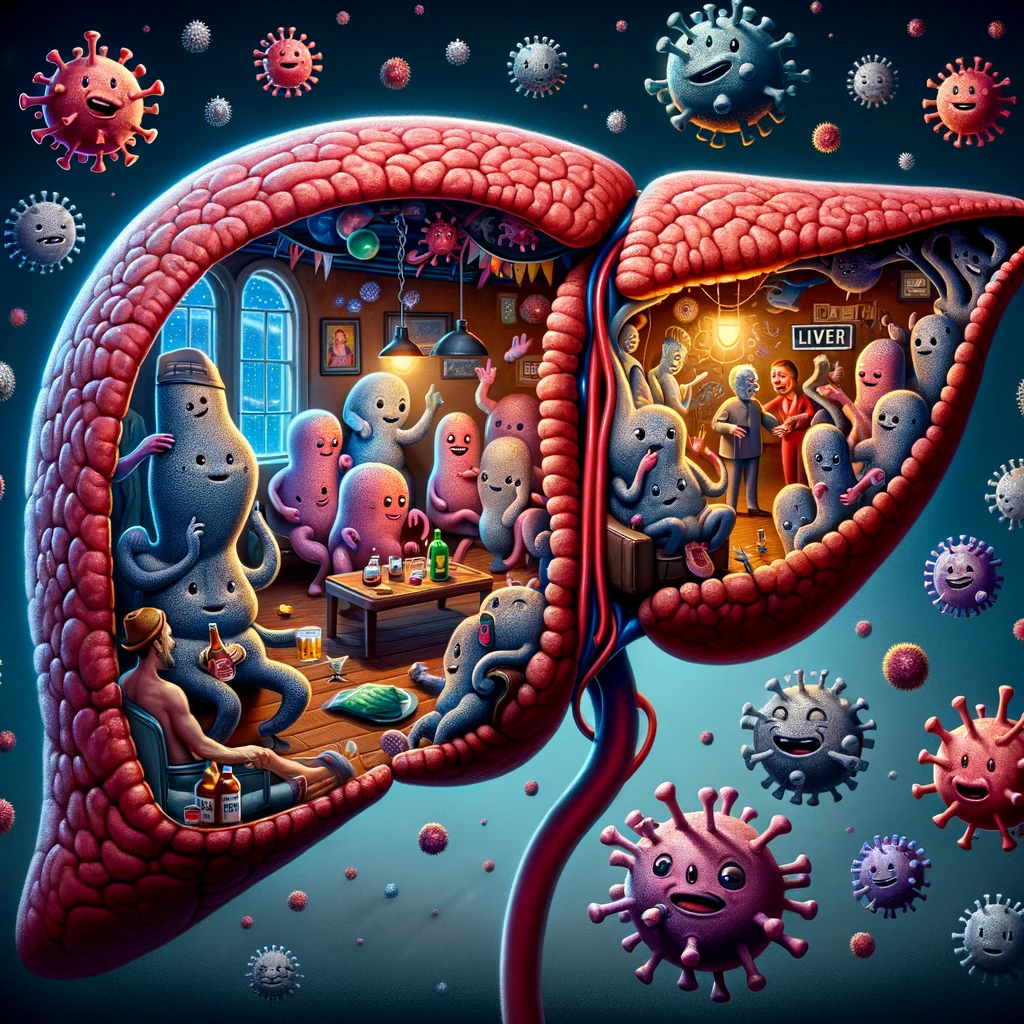
Hepatitis B and C are like those stealthy ninjas of the virus world. They sneak into your liver and start their silent but deadly mission. And here’s the kicker: they’re so good at flying under the radar, you won’t even know they’re there for years. No symptoms, no signs – just undercover destruction.
Fast forward, and the aftermath isn’t pretty. If these viruses go unchecked, they’re not just crashing the party; they’re trashing the whole house. We’re talking serious liver drama – failure, cirrhosis (which is as bad as it sounds, like your liver turning into a scarred-up war zone), or even liver cancer. And all this time, you thought everything was cool because there were no loud noises or obvious mess.
So, what’s the moral of the story? Well, it’s not about stopping the party or living in fear of uninvited guests. It’s about being a smart host. Get your liver checked, know your guests (aka get screened for Hep B and C), and maybe keep an eye out for those silent party crashers. After all, the best parties are the ones where everyone enjoys themselves without causing a disaster in the kitchen!
8. When life gives you lemons, make lemonade. When life gives you HIV, turn it into a battle for health with humor, hope, and a whole lot of science!”
Alright, so imagine your immune system is like the world’s most diligent security team, right? They’re there to protect you from all sorts of invaders – viruses, bacteria, you name it. Now, enter HIV, the Human Immunodeficiency Virus. This sneaky little critter is like a spy that slips past your security team’s defenses and starts wreaking havoc from the inside. It’s like having a mole in the agency who knows all the secret handshakes.
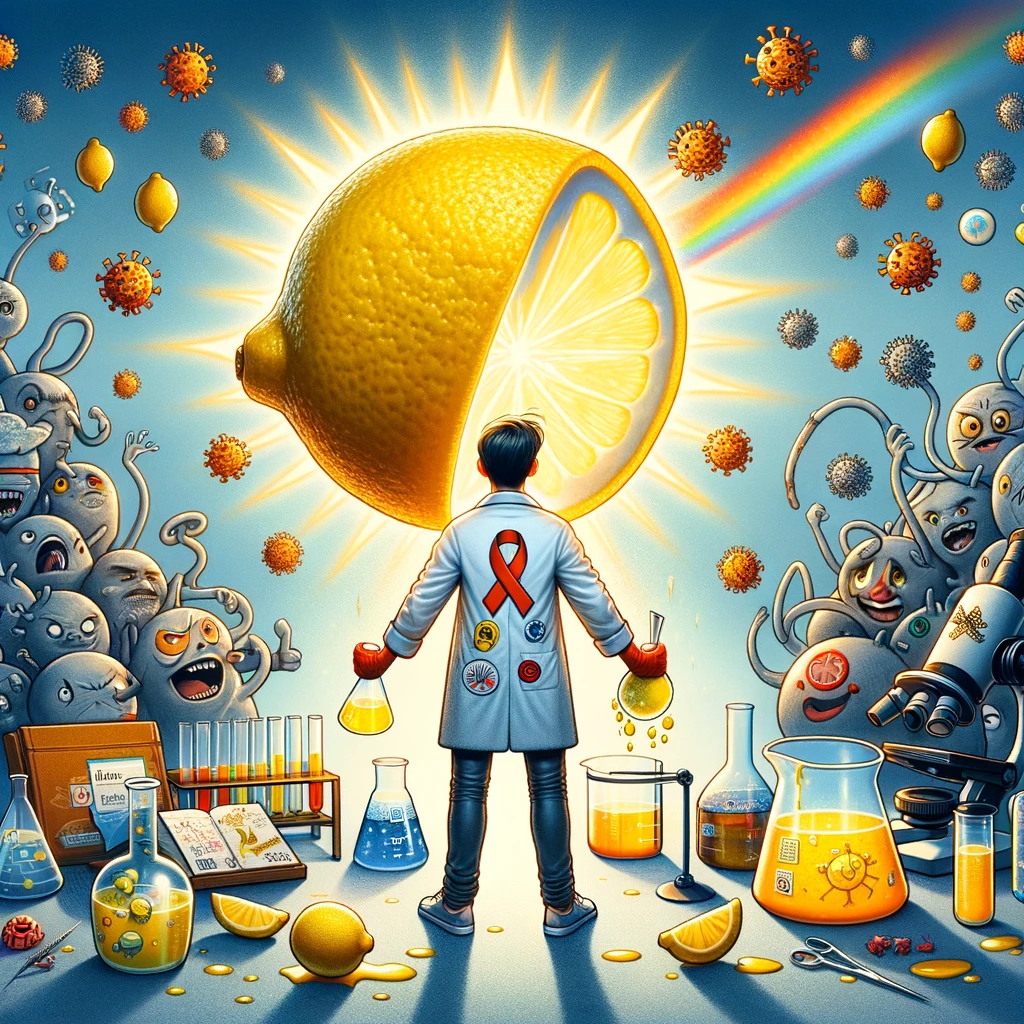
HIV’s main target is your immune system’s very own special forces – the CD4 cells. These cells are like the elite agents who coordinate your body’s defense strategies. But when HIV gets in, it turns these cells into its own little virus-making factories. Over time, this can lead to a serious breakdown in your body’s defense mechanisms.
Now, if HIV goes unchecked, it can progress to what’s called AIDS – Acquired Immunodeficiency Syndrome. Think of AIDS as the point where your immune system’s security team is so compromised that even the minor threats it could easily handle before now seem like massive breaches. This stage is like having your entire security apparatus in disarray, leaving you vulnerable to all sorts of health issues that otherwise wouldn’t be a big deal.

But here’s the kicker: early detection and treatment of HIV can seriously change the game. It’s like catching that mole early on and reinforcing your defenses, keeping your immune system’s security team strong and capable. With modern medicine, people living with HIV can lead healthy, long lives. It’s all about not giving that sneaky spy a chance to call in reinforcements. So, remember, regular check-ups and staying informed are your best allies in keeping your immune system’s security detail top-notch!
9. When your snore is so loud, even the neighbors need coffee in the morning
Alright, let’s chat about this sneaky little gremlin called sleep apnea. You know, that thing where your breathing decides to take a hike while you’re snoozing? Yeah, it’s like your body’s playing a game of Red Light, Green Light, but only when you’re out cold. Funny thing is, most folks don’t even know they’re playing this game because, duh, they’re sleeping!
Imagine this: You’re off to dreamland, counting sheep or whatever floats your boat, and bam! Your airway’s like, “Nah, let’s take a break,” and you stop breathing. Creepy, right? But your body, being the champ that it is, doesn’t let you tap out. It wakes you up just enough to kickstart the ol’ windpipe, but not enough to remember anything. So, you wake up feeling like you’ve run a marathon, not knowing you’ve been playing tag with your breath all night.

Now, you might think, “Ah, a bad night’s sleep, no biggie,” but hold up. This nightly game of freeze tag with your breathing isn’t just a party trick. It’s like leaving a tap running; eventually, there’s gonna be some damage. We’re talking serious stuff like heart disease, having a stroke, or even diabetes. Yeah, your snooze shenanigans could be setting you up for a not-so-great health adventure.
So, if you’re feeling more exhausted than a marathon runner at the finish line every morning, or your partner complains that your snoring could scare off a bear, it might be time to chat with a doc. ‘Cause, you know, it’s all fun and games until your sleep decides to mess with your health. Stay woke, folks—literally!
10. Keep your private parties VIP: No Crashers Allowed!
Ah, Chlamydia and Gonorrhea, the dynamic duo of the STI (Sexually Transmitted Infections) world, often sneaking around unnoticed but capable of causing a real ruckus in your health department if you let them linger. Imagine these two as the uninvited guests at the party in your pants – you might not even know they’ve crashed until things start to get out of hand.

Now, Chlamydia is kind of like that silent ninja, moving stealthily without making a sound (a.k.a. symptoms), making it a master of undercover operations. It’s the most common STI, but because it’s so sneaky, many people don’t realize they’re hosting this unwelcome visitor until it’s done some serious interior decorating in their reproductive system. Gonorrhea, on the other hand, is its slightly more boisterous partner in crime. It might give you a nudge here and there with some symptoms, but it’s also pretty good at blending into the background unnoticed.
Here’s where the plot thickens: even though these two might party quietly, they can throw one heck of a bash if left unchecked, leading to some serious health sequelae like infertility, pelvic inflammatory disease, and could even complicate pregnancies. And because they’re often mingling together, getting tested for both is like hitting two birds with one stone – you really don’t want to invite either to your next health check-up.

But here’s the kicker, both Chlamydia and Gonorrhea are totally crashable parties with the right antibiotics. It’s like calling the health police on these party poopers, and boom, they’re out of there. The real MVP move, though, is prevention. Condoms are like the exclusive bouncers at the entrance of your private party, keeping these uninvited guests at bay.
So, let’s keep the party in our pants a classy affair, invite only, with regular screenings and a strict dress code. Because nobody wants the aftermath of a wild STI party ruining the vibe.
Silent killers: Nature’s way of saying, ‘Checkmate.’ Time for a health checkup rematch!
In exploring “silent killer” diseases, we’ve delved into conditions that quietly undermine health, often unnoticed until critical stages. This journey highlighted the importance of awareness, early detection, and proactive healthcare measures in combating these diseases. It emphasized regular health screenings and healthy lifestyle choices as key defenses.

Through stories of resilience and advances in science, a message of hope and action emerges. This exploration calls for a collective response—prioritizing health, advocating for early detection, and supporting research—to combat these silent threats effectively. Together, we can turn silent alarms into a loud, unified front against these diseases, promoting well-being and preventive care.